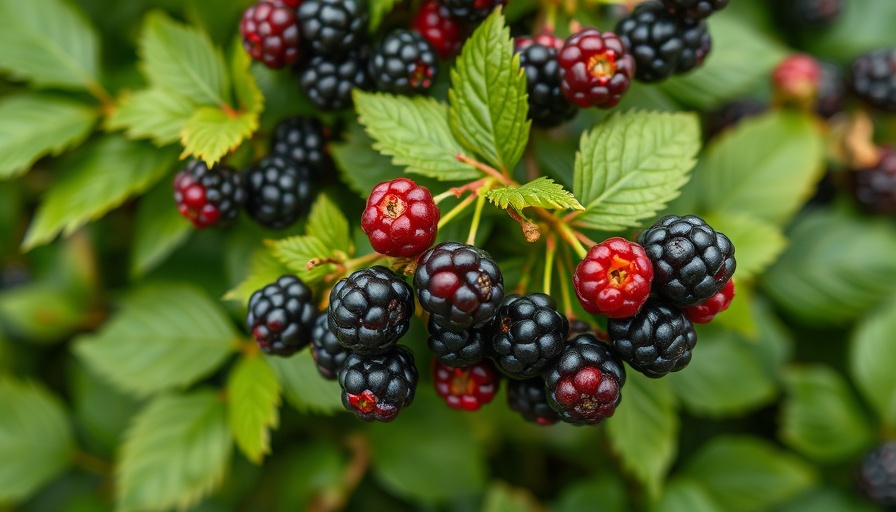
Unearthing the Bramble: What Are They?
Bramble refers to plants in the Rubus genus, which includes over 200 diverse species ranging from blackberry to raspberry. Each of these prickly perennials brings its unique character to our gardens, tempting gardeners with their intriguing nature. The name 'bramble' derives from the Old English word meaning 'broom,' aptly capturing the wild, loosely tangled growth of these plants.
The Riddle of Wild vs. Cultivated
In the gardening world, brambles often evoke imagery of unwelcome invasiveness. This perception can be compared to how we view other plants based on their locations—think of amaranth, revered as a crop but often labeled a weed when sprouting unexpectedly in a flower bed. The Himalayan blackberry, notorious for its tenacious growth, exemplifies this stereotype; yet when cultivated in the right conditions, the fruit it bears is a gardener's delight. This dichotomy invites us to explore our gardens with curiosity and appreciation, identifying opportunities rather than obstacles.
Common Species That Every Gardener Should Know
Among the many members of the Rubus family, some deserve special mention. The most prominent species include:
- Raspberry (Rubus idaeus): The bramble that many gardeners cherish for their sweet, tart fruits, ideal for jams and desserts.
- Blackberry (Rubus fruticosus): Known for their robust taste, blackberries are rich in nutrients and make a fantastic addition to any home garden.
- Loganberry (Rubus × loganobaccus): A juicy hybrid of blackberry and raspberry that adds a unique flavor profile to dishes.
- Boysenberry (Rubus ursinus × Rubus idaeus): Another hybrid beloved for its delicious, juicy berries that burst with flavor.
- Tayberry (Rubus fruticosus × Rubus idaeus): Known for its berry that is a cross between a blackberry and a raspberry, offering an exquisite taste.
Growing Requirements: Success in Your Garden
To cultivate brambles successfully, it’s essential to provide the right environment. These plants thrive in well-drained soil enriched with organic matter—compost works wonders! They prefer sunny spots, ideally receiving six to eight hours of sunlight daily. Since their canes are biennial, pruning is vital in maintaining health and productivity. Remove dead canes each winter to make way for new growth, and don’t forget to water regularly, especially during dry spells.
Think You Can Remove Brambles? Here Are Tips!
When brambles outstay their welcome, removal can be daunting. Begin by clearing the area of surface debris and using pruning shears to remove the canes at ground level. Be sure to wear gloves, as thorns can pose a risk. Digging out the roots is crucial—any remnants left behind may sprout anew! If they are persistent, applying organic mulch or ground cover can help prevent regrowth.
The Future of Bramble Gardening
As more gardeners lean toward sustainable practices, the cultivation of bramble plants may see a renaissance. Consider growing these species not just for their fruit, but also for their role in attracting beneficial wildlife like pollinators and birds to your outdoor space. Their thorny branches can provide natural deterrents to larger pests while contributing to the biodiversity of your garden.
Actionable Insights for Gardeners
Before you dig in, here are some immediate steps to consider if you want to incorporate brambles into your landscape:
- Start with a soil test to understand its pH and nutrient levels, allowing you to amend it for optimal Rubus growth.
- Consider planting companion plants that thrive alongside brambles—examples include spring-flowering plants that help attract pollinators.
- Implement sustainable gardening practices by using organic fertilizers that create a lasting impact on soil health.
Conclusion
Bramble plants may come wrapped in thorns, but they also offer sweet rewards. With proper care and placement in your garden, these members of the Rubus genus not only bring beautiful fruits to our tables but also help bolster the ecosystem in our backyards. Now is the time to embrace their potential and make them a permanent feature in your garden.
 Add Row
Add Row  Add
Add 




Write A Comment